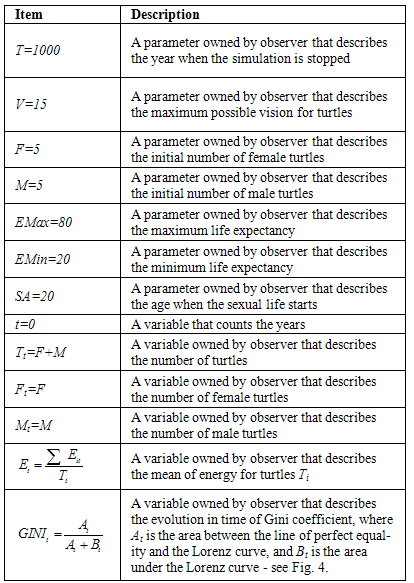-
Paper Information
- Next Paper
- Previous Paper
- Paper Submission
-
Journal Information
- About This Journal
- Editorial Board
- Current Issue
- Archive
- Author Guidelines
- Contact Us
American Journal of Economics
p-ISSN: 2166-4951 e-ISSN: 2166-496X
2011; 1(1): 15-20
doi: 10.5923/j.economics.20110101.02
An Agent-based Computational Study of Wealth Distribution in Function of Technological Progress Using Netlogo
Romulus Catalin Damaceanu
Department of Economic Sciences, Petre Andrei University of Iasi, Iasi, 700400, Romania
Correspondence to: Romulus Catalin Damaceanu , Department of Economic Sciences, Petre Andrei University of Iasi, Iasi, 700400, Romania.
| Email: |  |
Copyright © 2012 Scientific & Academic Publishing. All Rights Reserved.
In this paper, we computed Gini coefficient in function of technological progress modeled using agent-based methodology in the frame of NetLogo software. We start from the simplest type of society (agrarian society), continue with the industrial one where we model the phenomenon of industrial revolution with four waves, and end with green revolution with other four waves. The conclusion is that technological progress has a negative influence on equality of wealth distribution measured by Gini coefficient and this is explained by the heterogeneity of turtle's population given by their variable vision.
Keywords: Gini Coefficient, Agent-Based Methodology, Netlogo Software, Technological Progress, Renewable and Nonrenewable Resources
Cite this paper: Romulus Catalin Damaceanu , "An Agent-based Computational Study of Wealth Distribution in Function of Technological Progress Using Netlogo", American Journal of Economics, Vol. 1 No. 1, 2011, pp. 15-20. doi: 10.5923/j.economics.20110101.02.
Article Outline
1. Introduction
- Agent-based Computational Economics applies an interdisciplinary approach that combines knowledge from Agent-based Computational Modeling and Economics with the scope to observe, to analyze and to discuss the evolution of an economic system composed by intelligent agents. Agent-based Computational Modeling involves research in areas of science where computing plays a central and essential role, emphasizing agents seen as entities that encapsulate other agents, procedures, parameters, and variables. Agent-based Computational Modeling is a branch of Applied Computational Mathematics that currently is the field of study concerned with constructing mathematical models and numerical solution techniques by using computers in order to analyze and solve scientific, social scientific and engineering problems (Damaceanu 2010).The literature of agent-based computational economics and evolutionary economics try to create a consistent theory using the process described in Figure 1, where from using a combination of definitions and assumptions, the scientist builds a theory (an agent-based model) to be confronted with real economic phenomena. After this evaluation that uses econometric studies the theory is considered to be consistent with the observed reality or non-consistent. In the first case, there is a provisional acceptance of the theory. Inthe second case, is going full rejection or possibly changed assumptions as a result of observations made and the process is retaken on new forms.Figure 1 shows us clearly that the process is divided in two major parts. The first part consider what is called Normative Economics that expresses value judgments (normative judgments) about economic fairness or what the economy ought to be like or what goals of public policy ought to be. The second part enter in the sphere of Positive Economics that is the branch of Economics that describes and explains economic phenomena focusing on facts and cause-and-effect behavioral relationships and includes the development and testing of economics theories (Samuelson and Nordhaus 2004).
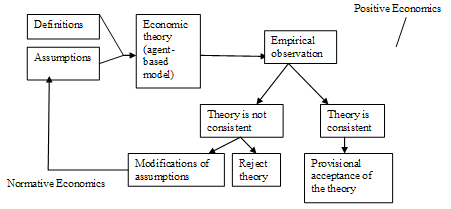 | Figure 1. The process of creating an economic theory. |
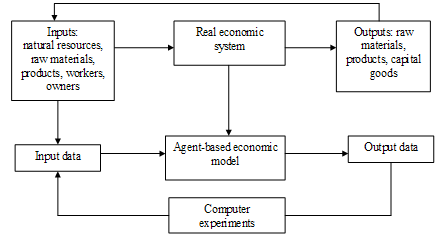 | Figure 2. The relation between real economic system, economic theory/ model and computer experiments. |
2. The Methodology
- The main construction blocks of any agent-based computational model (ACM) are the following: the set of agents (A), the initializations (I) and the simulation specifications (R) – see (Figure 3).
 | Figure 3. The elements of ACM. |
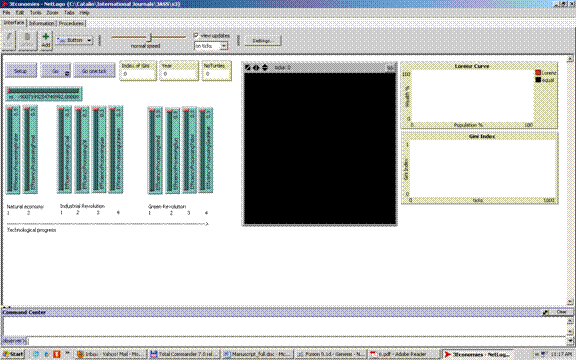 | Figure 4. The interface tab of NetLogo software platform. |
3. Conceptual Validation
- Despite the fact conceptual validation is very important there is little literature that addresses this issue (Robinson 2006). According to Heath (2009), the conceptual model forms the foundation of an ABM model; an invalid conceptual model indicates the model may not be an appropriate representation of reality.
3.1. The Analysis of Real Economic Systems
- In this subsection we analyze the main features of economic systems implemented by the following types of society:(i) Agrarian society is based on natural economy defined as a system where the majority of goods are produced for direct consumption (subsistence).(ii) Industrial society implemented the process of social and economic change that transforms a human group from an agrarian type into an industrial one for the purpose of manufacturing goods not destined for direct consumption.(iii) Green society generates a new type of economy called green economy that results in improved human well-being and social equity, with reducing environmental risks by implementing a new way of economic development based mostly on renewable resources.
3.2. Defining the Objective of Research and the Precise Task of the Model
- Taking into account these three types of economic systems we defined the purpose of research as being the relation between technological progress and the distribution of wealth. The technological progress is implemented like a set of major changes in agricultural and industrial sectors. As we know both types of sectors use resources like water, food, coal, oil, gas, uranium, wind, sun, tides, and geothermal heat. To model the phenomenon of technological progress we conceived an agent-based artificial society described in Damaceanu (2011) as an evolutionary system that starts from the simplest type of economy (natural economy based only on water and food resources), continue with the industrial economy (that uses with maximum efficiency the resources of natural economy and discover nonrenewable resources such as coal, oil, gas, and uranium), and ends with the new economy (still using with maximum efficiency the resources of natural and industrial economies if they are available) based on renewable resources like wind, sun, tides, and geothermal heat. The technological progress is introduced in this model in linear way starting from agricultural technologies used in the case of natural economy, continuing with industrial technologies used for extracting nonrenewable resources in the following order coal, oil, gas, and uranium and ending with nonrenewable resources used in the following order wind, sun, tides, and geothermal heat.The distribution of wealth is analyzed using Gini coefficient - see (Gini 1912). This coefficient is a measure of the inequality of a distribution, a value of 0 expressing total equality and a value of 1 maximal inequality. This index is defined as a ratio of the areas on the Lorenz curve diagram - see Figure 5.
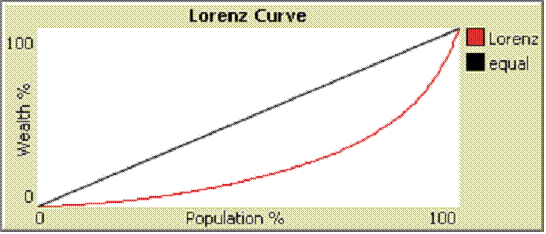 | Figure 5. Graphical description of Lorenz Curve. |
3.3. Building the Conceptual Model
- In section 2, we defined agent-based computational model (ACM) like a list of three arguments: the set of agents (A), the initializations (I) and the simulation specifications (R). The process of building the conceptual model can be defined like constructing the initial set of agents (A0), setting the initial values of initializations (I0) and specifying the initial values for simulation specifications (R0) - see Figure 6, for a graphical description of the process. This figure shows us how the initial form of the ACM0 enters in the phase of conceptual validation. If this validation fails the conceptual model is modified in a new form ACM1 and the process is reiterated until conceptual validation is a success and the model become subject to operational validation.
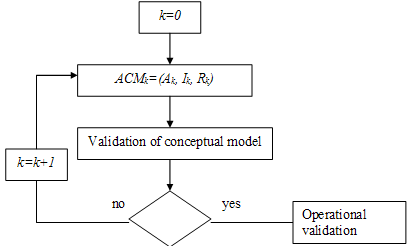 | Figure 6. The process of building the conceptual model. |
3.4. Validation of Conceptual Model
- The validation of conceptual model is a process that checks the integrity of all component elements of agent based model ACMk divided in three major sets: the set of agents Ak, the set of initializations Ik and the set of simulation specifications Rk. In our case, because the model is developed in the frame of NetLogo software platform, we have the following set Ak = {O, Ti, Pxy}, where O is the observer agent that does not have a specific location - we can imagine it like an entity that observes the world composed by its sub-agents turtles Ti, and patches Pxy - see Figures 7-9.
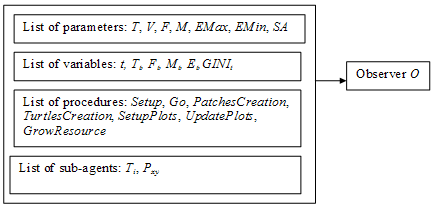 | Figure 7. The elements of Observer O. |
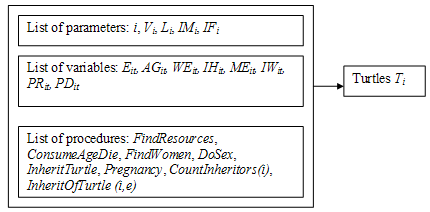 | Figure 8. The elements of turtles Ti. |
 | Figure 9. The elements of patches Pxy. |
|
|
4. Operational Validation
- Operational validation can be defined as the transformation process of conceptual model in a model recognized by the software used (in our case NetLogo).
4.1. Transformation of Conceptual Model in a Computerized Model Using NetLogo Software Platform
- In our case we used NetLogo 4.0.5 and, under these circumstances, we followed the cycles (see Figure 10):- Cycle (1): modification of simulation specifications;- Cycle (2): modification of parameters;- Cycle (3): modification of initial values of variables;- Cycle (4): modification of procedures;- Cycle (5): development of new agents.
 | Figure 10. The cycles of operational validation of ACM. |
4.2. The Operational Validation of Computerized Model
- The operational validation is a technique that facilitates a more direct correspondence between the entities in the target system and the parts of the model that represent them (Edmonds 2001). This enhances the descriptive accuracy of the modeling process, but it can also create difficulties. Under these circumstances, almost every operational validation of agent-based models may contain bugs defined as code that does something different in comparison with what you expected (Gilbert 2007). As Axelrod underlines, you have to work hard to confirm that the operational validation is really valid (Axelrod 1997). In addition, Axtell and Epstein state that “the robustness” of macrostructures to perturbations in individual agent performances is specific to agent-based models and makes very hard to identify bugs (Axtell and Epstein 1994).Computer experiments can be seen as a branch of applied statistics, because the user must take into account the next sources of uncertainty:(i) First, the models may contain parameters whose values are not certain; (ii) Second, the models themselves are imperfect representations of the studied system; (iii) Third, data collected from the system that might be used to calibrate the models are imperfectly measured.Taking into consideration the evolution in time of economy described in Figure 11, we will do 9 computer experiments described in Table 4.
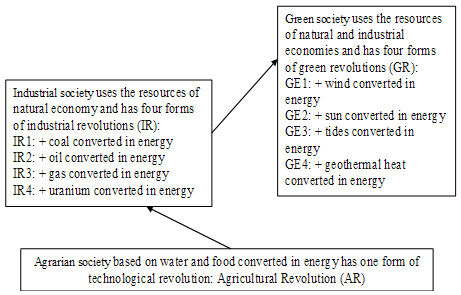 | Figure 11. The evolution in time of economy. |
|
5. Conclusions
- Based on data obtained after running the nine computer experiments, we computed the average value of Gini coefficient and using these averages we can describe the evolution of mean value of Gini coefficient in the case of experiments E1-E9 - see Table 5 and Figure 12.
| |||||||||||||||||||||||||||||||||||||||||||||||||||||||||||||||||||||||||||||||||||||||||||
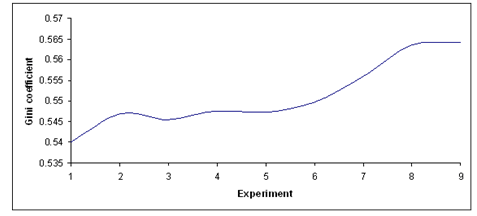 | Figure 12. The evolution of mean value of Gini coefficient in the case of experiments E1-E9. |
References
| [1] | R.M Axelrod, "Advancing the Art of Simulation in the Social Sciences", in R. Conte, Hegselmann R, and Terna P. (eds.) Simulating Social Phenomena, Lecture Notes in Economics and Mathematical Systems, 456, 21-40. Berlin: Springer-Verlag, 1997 |
| [2] | R.L. Axtell, and Epstein J.M, 1994, Agent-based Modeling: Understanding Our Creations. The Bulletin of the Santa Fe Institute, Winter, 28-32 |
| [3] | R.C. Damaceanu, Agent-based Computational Social Sciences using NetLogo, Lambert Academic Publishing, 2011 |
| [4] | R.C. Damaceanu, Applied Computational Mathematics in Social Sciences, Sharjah: Bentham Science Publishers, 2010 |
| [5] | B. Edmonds, The Use of Models - making MABS actually work, in MOSS S and DAVIDSSON P (Eds.), Multi-Agent-Based Simulation, Lecture Notes in Artificial Intelligence 79: 15-32. Berlin: Springer-Verlag, 2001 |
| [6] | N. Gilbert, Agent-Based Models. Quantitative Applications in the Social Sciences. London: SAGE Publications, 2007 |
| [7] | C. Gini, Variabilità e mutabilità (Variability and Mutability), Bologna: C. Cuppini, 1912 |
| [8] | B. Heath, Hill, R. and Ciarallo, F., 2009 'A Survey of Agent-Based Modeling Practices (January 1998 to July 2008)'. Journal of Artificial Societies and Social Simulation 12(4)9 |
| [9] | S. Robinson, 'Conceptual Modeling for Simulation: Issues and Research Requirements', Proceedings of the 2006 Winter Simulation Conference, 792-800, 2006 |
| [10] | P.A. Samuelson, and Nordhaus, W.D. 'Glossary of Terms, "Normative vs. positive economics"'. In: SAMUELSON PA, NORDHAUS WD (2004) Economics, 18th ed., McGraw-Hill, 5-6, 2004 |
 Abstract
Abstract Reference
Reference Full-Text PDF
Full-Text PDF Full-Text HTML
Full-Text HTML